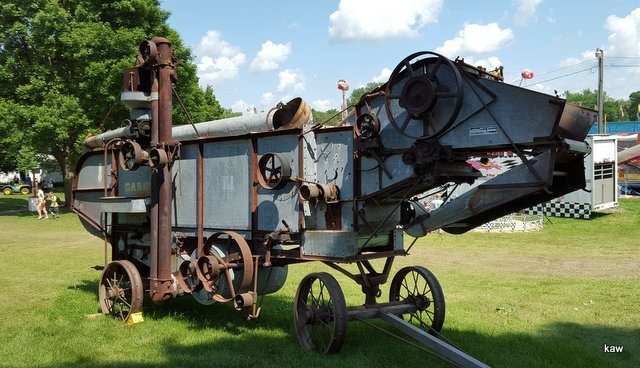
Submitted by Wayne Roberts
Threshing Preparations
Farming in Howard County has changed a great deal during my lifetime. Most farms ran a standard crop rotation of corn, oats and hay. This was necessary to provide feed for the animals. As August nears, I remember that it was time to prepare for the oats harvest. The first step was to get out the binder canvases to see if they needed repair. Mike Mertens of the shoe repair shop was very good at this job. Next, when the grain was ripe it was cut and bundled, and the operator would drop the accumulated bundles into rows. This made it easier for the next step, to pile the bundles into shocks, which kept the grain heads off the ground while waiting for the threshing machine.
Threshing
The actual threshing was a labor intensive process, needing ten to twenty men to keep the machine supplied with bundles, haul away and store the grain, and manage the straw pile, as well as an operator for both the threshing machine and the power supply. Two or three neighbor ladies would combine to provide a heavy “lunch” for the crew, which ate in shifts as work allowed. Our threshing “ring” consisted of farmers on the north side of the Upper Iowa. The problem was that the threshing machine lived in the off season on the south side of the river. Morris Jones owned the machinery, a 36 inch Case threshing machine and a 30-60 Aultman-Taylor tractor. The tractor was a huge thing, with the iron drive wheels that looked (to me) to be a t least ten feet in diameter! There is an example of this machine in the Prairie Village Museum in Minden, Nebraska. No one dared to drive this monster across the old bridge it Old Town, so my dad, Archie Roberts, drove it up over the Hogsback, across country, and crossed the river at a low water crossing just downstream from what is now “The Girls” farm.
Threshing Ring
Members of this ring: Archie Roberts, Ed “Bill M” Jones, Fred Latcham, Henry Wesseling, Herman Ihns, Clarence Groteboer, John Martin, John Davis and others. My link with those days was that in later days, I actually worked a team of horses on a bundle wagon for a full day. These were long days, for the farmers need to be up early to do “chores” which usually included milking several cows, then hitch up the team and drive to the threshing site, then home again after threshing for more chores!
Editor’s Note:
The picture at the top is a much smaller Case threshing machine than the one Wayne remembered. This one was a 26-inch Case, as I recall. The picture was taken at the Jones County Fair this year.